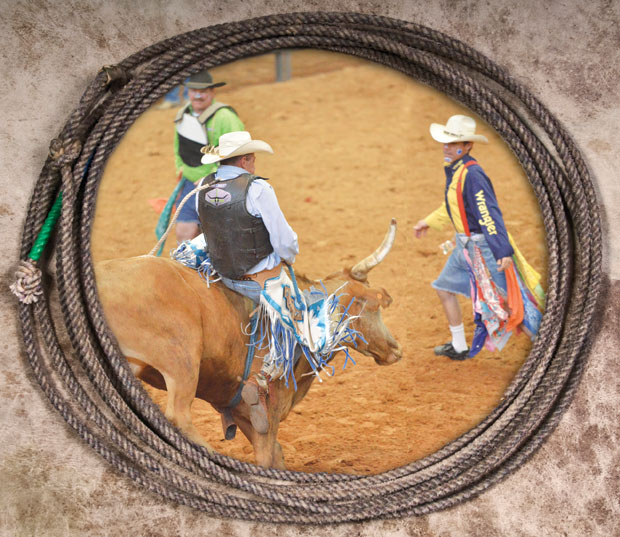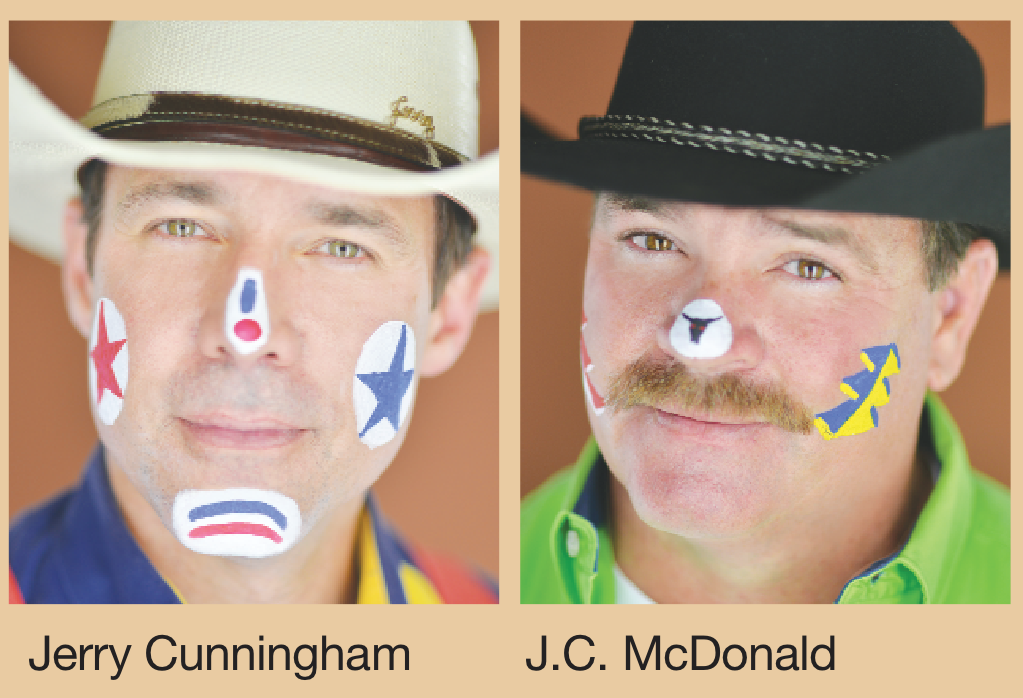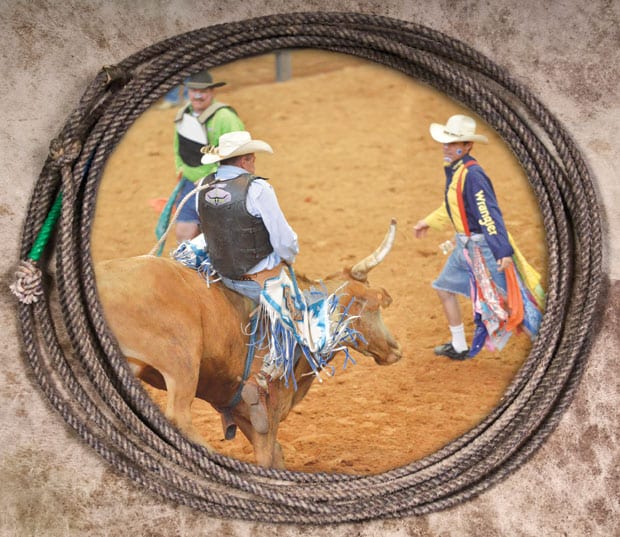Jerry Cunningham and his partner J.C. McDonald help keep the competitors safe in the arena at the World Gay Rodeo Finals

FACE OFF | Jerry Cunningham, right, and J.C. McDonald, near left, get ready to move in to distract the bull as a cowboy nears the end of his ride. (Photo ©CowboyFrank.net)
In the world of rodeo, there’s a difference between being wrecked and being racked. Jerry Cunningham has experienced both.
Cunningham, who also happens to be owner and publisher of Out Front, an LGBT newsmagazine in Colorado, has been active on the LGBT rodeo circuit for about 25 years. His partner of 15 years, J.C. McDonald, is also a rodeo cowboy.
Although both started out as competitors, now they spend most of their time at the rodeo keeping other competitors safe in their roles as the International Gay Rodeo Association’s official rodeo clowns/bullfighters. Both Cunningham and McDonald are in Fort Worth this weekend for the IGRA’s 2014 World Gay Rodeo Finals.
Cunningham said he was fascinated with rodeo from the first time he saw it. But he didn’t have the training or the experience to compete in any of the traditional rodeo events, like the rough stock events (bareback bronc or bull riding), or the less dangerous events like barrel racing or calf roping, which still require great skill.
Fortunately for Cunningham, though, Wayne Jakino, the man who founded IGRA, “knew there were a lot of these gay boys who would want to be part of the rodeo, but who could never be ropers or bull riders,” he said. So for them, Jakino created a series of what are, basically, relay races — but with a very gay and very rodeo flavor. They are called goat dressing, steer decorating and the wild drag race.
These three events are unique to the gay rodeo circuit, and while they sound relatively easy at first, each event does take some finesse. And none of them are without risk.
In goat dressing, teams of two compete to be the first to get a pair of men’s tighty-whitey underwear onto the rear end of a goat, which has been tethered in the center of the arena. In steer decorating, teams of two work together to chase a steer around the arena, then while one team member holds the steer still, the second ties a ribbon on its tail. For the wild drag race, teams of three are tasked with getting a — usually uncooperative — steer out of a chute and across a finish line while one team member — in drag — rides on its back.
“I started out in the goat dressing competitions,” Cunningham said. “That’s where most people start. Then, when you graduate, or maybe when you get a little more courageous, you move up to the steer decorating. Then when you conquer that, you move up to the wild drag race.”
He added, “J.C. started as a competitor in the speed events — barrel racing, pole bending, flag racing.”
Eventually, both men moved up to compete in the rough stock events, including rodeo’s most “glamorous” — and potentially dangerous — event, the bull riding.
Cunningham said he competed as a rough stock rider for about nine years before deciding to take a crack at it from the other side of the bull. But being a rodeo clown takes just as much training and practice as being a competitor — if not more.
So Cunningham decided to apprentice with the best in the gay rodeo business, rodeo clown and bullfighter David Pizzuti. He got his first chance to work as clown/bullfighter by himself at a gay rodeo in Oklahoma.
Then McDonald, after riding bulls himself for six or seven years, decided to make clowning a family business, and after serving his apprenticeship with Cunningham, he now works alongside his partner in the arena.
Some people think of the guys with the painted faces and the funny clothes simply as pranksters, just there to entertain the crowd. But the clown/bullfighter’s primary purpose is to keep the competitors safe. And, Cunningham said, there is a difference in the role of the “clown” and the role of the “bullfighter.” The two usually work in partnership during the rough stock events.
The job of the bullfighter, Cunningham said, is to be ready to move in and distract the bull or horse if a rider is thrown. The bullfighter gets the animal’s attention, drawing it away long enough to give the rider time to get to safety. In the event a rider gets tangled in the “rigging” — the ropes or reins they use to try and keep their seat on the angry animal — the bullfighter will move in to help them get free before they get hurt.
“I’ve kind of stepped back recently and let [McDonald] take more of the front seat in terms of being the bullfighter,” Cunningham continued. “I concentrate more on the role of being the clown.”
The clown, he continued, is there to entertain the crowd with silly gags and skits and antics. But he also has to be ready at a moment’s notice to move in and assist if a competitor or the bullfighter gets in trouble. And when you have a couple tons of belligerent bovine on the loose, accidents can and do happen.
And that is where the wrecks happen.
“I’ve seen a lot of wrecks in my years with the rodeo,” Cunningham said. You know, I rode bulls for nine years, and I have decided that I feel safer in front of the bull rather than on its back.
“There have certainly been some scary moments,” he continued. “The worse you could possibly imagine happening has happened, not more than two feet in front of me.”
Cunningham said he doesn’t like to talk about that incident. But he did describe one wreck that could have been much, much worse.
“I was in Las Vegas, working at their [gay] rodeo there. Now, one of the first things you learn as a rodeo bullfighter is never stand square to the chute. When they open that gate up, that bull is coming straight out of, and if you’re standing in the way, he will run over you,” Cunningham said. “Well this time, I messed up. I was standing square to the chute when they opened the gate.”
Appropriately enough for a rodeo in Las Vegas, the bull that came out of the chute was named Elvis, he said. “And Elvis hooked me. He got his horn between my legs and popped me up in the air. They told me later I went about 15 feet up.
“Well, while I was flailing around up in the air, the bull ran underneath me. But when I came down, I landed on my feet,” Cunningham recalled. “It took me a second, you know. I was like, wow, that really just happened. I looked up at the announcer, who was looking down at me with a ’good god are you ok’ look on his face. I nodded at him to let him know I was OK, then I turned around and hammed it up for the audience, pretending I had been racked, groaning and howling and carrying on.”
Other than being “really sore ‘down there’ for a few days,” Cunningham wasn’t injured in that wreck. But he knows he was fortunate. Less than inches, fewer than seconds separated him from serious injury or death.
“That was a real turning point for me,” he said, “a very sobering moment. Up until then, I’d been like, ‘I’m invincible!’ But that proved to me I wasn’t invincible at all.
“My confidence was compromised when that happened,” he admitted. But after a pause, he added, “But not enough to make me quit. I am the official IGRA rodeo clown and bullfighter. I have had dozens and dozens of injuries. I’ve been kicked. I’ve dislocated my shoulder. I’ve tried to retire three different times. But they won’t let me. I guess there just aren’t any other rodeo clowns willing to come do their schtick at the gay rodeo.”
Cunningham does have a life outside the rodeo circuit. He worked for years as a publicist for the city of Arvada, a suburb of Denver. “When that tour of duty came to an end” in 2011, he said he did some part-time work and some consulting and marketing stuff.
Then in November 2011, “I was laying in my bed, just speaking to the universe,” Cunningham said. “I said I’ve had the cush, high-profile job. What I want now is a job that affords me the opportunity to make a bigger difference. I don’t need a bunch of accolades. I just want to make a difference.
“Literally a week later,” he said, Mark Richardson called to urge him to buy Colorado’s LGBT newsmagazine. “I didn’t answer the phone, just let it go to voice mail. He told me that Out Front was quietly for sale, and ‘you’re the next owner. Call me.’ I didn’t want to do that. I deleted the message.”
Richardson called him back the next week, “mad as hell” that Cunningham hadn’t returned the call. “He said, ‘I’m not asking. You’re going to take a meeting’” with the owners looking to sell.
“A month later, there we were,” signing papers to make Cunningham the new owner of Out Front.
When Richardson first broached the subject, Cunningham said he was adamant. “I told him, why would I want to buy the Titanic? Why would I want to invest in what looked like a sinking ship? But now I know it was the best decision of my life, hands down. I have an awesome life now. That’s the short version of it!”
……..
Let’s Rodeo!
 The International Gay Rodeo Association’s 2014 World Gay Rodeo Finals takes place through Sunday at John Justin Arena, 1051 Rip Johnson Road in Fort Worth.
The International Gay Rodeo Association’s 2014 World Gay Rodeo Finals takes place through Sunday at John Justin Arena, 1051 Rip Johnson Road in Fort Worth.
The IGRA Royalty contest began Thursday night at the Rose Room inside Station 4 in Dallas, and continues tonight at 8 p.m. at the Hilton Arlington, 22401 E. Lamar Blvd. in Arlington.
Rodeo competition begins at 9 a.m. Saturday and 9 a.m. Sunday, with the grand entry being held at about noon each day, at John Justin Arena. Food, drink and merchandise vendors will be open throughout both days.
The event schedule for both Saturday and Sunday is: 1. calf roping on foot; 2. steer decorating; 3. mounted break-away roping; 4. team roping; 5. steer riding; 6. goat dressing; 7. grand entry; 8. bareback bronc riding; 9. chute-dogging; 10. pole bending; 11. wild drag race; 12. barrel racing; 13. flag racing; 14. bull riding.
Tickets for individual days are $15 for adults. Two-day passes are $25 for adults. Children under 12 are admitted free.
This article appeared in the Dallas Voice print edition October 17, 2014.











